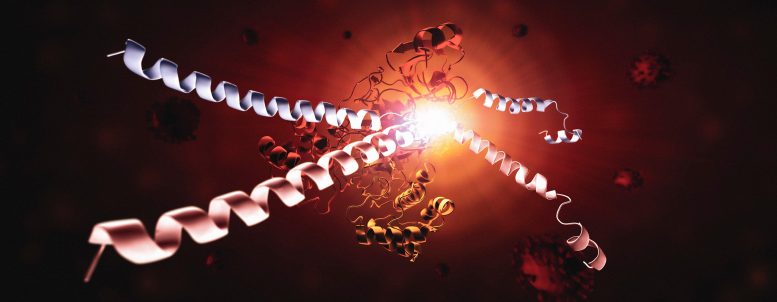
This image shows the SARS-CoV-2 virus’s main protease, Mpro, and two strands of a human protein, called NEMO. One NEMO strand (blue) has been cut by Mpro, and the other NEMO strand (red) is in the process of being cut by Mpro. Without NEMO, an immune system is slower to respond to increasing viral loads or new infections. Seeing how Mpro attacks NEMO at the molecular level could inspire new therapeutic approaches. Credit: Greg Stewart/SLAC National Accelerator Laboratory
Powerful X-rays from the SLAC synchrotron show that the fundamental wiring of our immune system seems to be no match for the vicious SARS-CoV-2 protein.
Scientists have examined the SARS-CoV-2 virus in great depth over the last two years, laying the foundation for COVID-19 vaccines and antiviral treatments. Researchers at the Department of Energy’s SLAC National Accelerator Laboratory have now seen one of the virus’s most crucial interactions for the first time, which might aid in the development of more precise treatments.
The researchers captured the moment when a viral protein called Mpro slashes a protective protein called NEMO in an infected individual. Without NEMO, the immune system is slower to react to growing viral loads or new infections. Understanding how Mpro targets NEMO at the molecular level may provide new treatment strategies.
Researchers exposed crystalline samples of the protein complex to intense X-rays from SLAC’s Stanford Synchrotron Radiation Lightsource (SSRL) to see how Mpro cuts NEMO. The protein samples were hit by X-rays, which showed what Mpro looks like when it disables NEMO’s primary function of facilitating immune system communication.
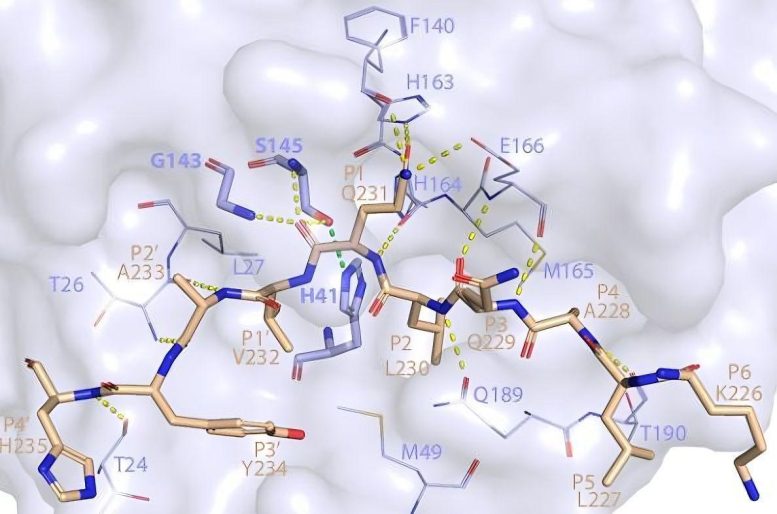
This image shows how SARS-CoV-2 Mpro recognizes and cuts NEMO based on the crystal structure determined using a powerful X-ray beam at SSRL Beam Line 12-2. Credit: SLAC National Accelerator Laboratory
“We saw that the virus protein cuts through NEMO as easily as sharp scissors through thin paper,” said co-senior author Soichi Wakatsuki, professor at SLAC and Stanford. “Imagine the bad things that happen when good proteins in our bodies start getting cut into pieces.”
The images from SSRL provide the first structure of SARS-CoV-2 Mpro bound to a human protein and show the precise location of NEMO’s cut.
“If you can block the sites where Mpro binds to NEMO, you can stop this cut from happening over and over,” SSRL lead scientist and co-author Irimpan Mathews said. “Stopping Mpro could slow down how fast the virus takes over a body. Solving the crystal structure revealed Mpro’s binding sites and was one of the first steps to stopping the protein.”
The research team from SLAC, DOE’s Oak Ridge National Laboratory, and other institutions recently published their results in the journal Nature Communications.
Protecting an immunity pathway
NEMO is part of a human immune system known as the NF-κB pathway. You can think of NEMO and the NF-κB pathway as if they were a card reader and wiring on the outside of a locked building entrance door. If the wires to the card reader are cut, the door will not open, meaning a person (or an immune system activator, like NEMO) is stuck outside, unable to do whatever they came to do.
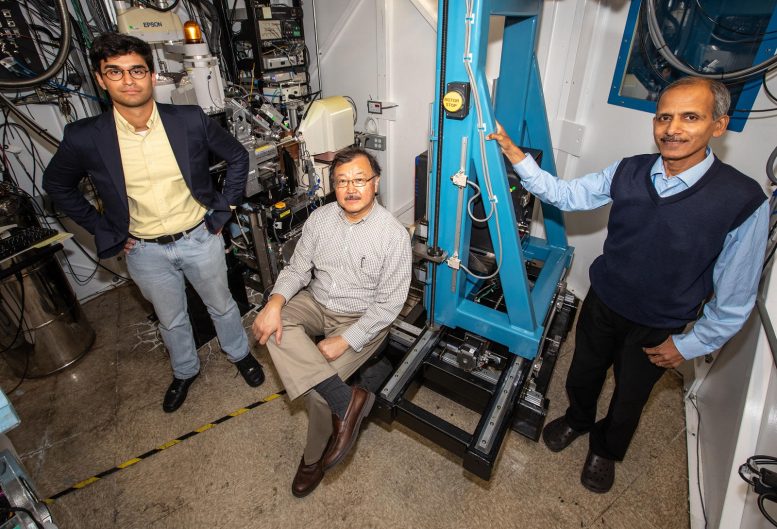
Researchers stand near SSRL’s Beam Line 12-2. From left, Mikhail Hameedi, SLAC scientist and co-first author; Soichi Wakatsuki, co-senior author and professor at SLAC and Stanford; and Irimpan Mathews, SSRL lead scientist and co-author. Credit: Jacqueline Ramseyer Orrell/SLAC National Accelerator Laboratory
The NF-κB pathway is a critical part of protective inflammatory responses. When NEMO is cut, our immune response can’t be activated, resulting in various detrimental effects on our body. COVID-19 viral infections could be made worse if Mpro destroys NEMO, helping the virus evade our innate immune responses. Additionally, a separate study by researchers at institutions in Germany found that the loss of NEMO by the action of Mpro could lead to damage in certain brain cells, causing neurological symptoms observed in COVID-19 patients, the researchers said.
One drug that is currently approved for emergency use targets Mpro proteins by providing an infected person with a Mpro inhibitor. This kind of inhibitor drug could be strengthened now that the location of NEMO’s cut has been observed.
“The crystal structures of NEMO and Mpro provide us with the targets to develop treatments that stop these cuts from happening,” SLAC scientist and co-first author Mikhail Ali Hameedi said. “Although current antiviral drugs can target Mpro, seeing the molecular details of how Mpro attacks NEMO will help us develop new treatments in the future as Mpro mutates.”
Finding ways to improve antiviral inhibitors is especially important with SARS-CoV-2. Among the coronaviruses—a group that includes the original SARS-CoV and MERS‐CoV viruses—SARS-CoV-2’s Mpro is the most effective at attaching to and cutting NEMO. SARS-CoV-2’s Mpro grabs NEMO with a tighter grip than its counterparts in other coronaviruses and could be cutting hundreds of other critical proteins in human host cells, such as those associated with blood disorders, the researchers said.
To predict how well Mpro binds to NEMO, researchers used the Summit supercomputer at the Oak Ridge Leadership Computing Facility. They combined molecular dynamics simulations with five machine learning models in a novel way and applied quantum chemistry, finding that Mpro likely has the highest binding affinity in SARS-CoV-2 compared to the other primary coronaviruses. In previous studies, these techniques helped scientists narrow down a list of potential antiviral inhibitor drugs.
“With a set of computational approaches, we were able to predict the strongest binding spots between NEMO and Mpro,” co-first author and ORNL scientist Erica Prates said. “We think that a high binding affinity at these hot spots helps explain the high fitness of the virus in humans.”
Moving forward, the biomedical industry could use the study to help build better inhibitor drugs and understand how other proteins could be affected by Mpro, Wakatsuki said.
“NEMO is only the tip of the iceberg,” he said. “We can now study what happens when many other proteins in the body are cleaved by Mpro during infection.”
Reference: “Structural and functional characterization of NEMO cleavage by SARS-CoV-2 3CLpro” by Mikhail A. Hameedi, Erica T. Prates, Michael R. Garvin, Irimpan I. Mathews, B. Kirtley Amos, Omar Demerdash, Mark Bechthold, Mamta Iyer, Simin Rahighi, Daniel W. Kneller, Andrey Kovalevsky, Stephan Irle, Van-Quan Vuong, Julie C. Mitchell, Audrey Labbe, Stephanie Galanie, Soichi Wakatsuki and Daniel Jacobson, 8 September 2022, Nature Communications.
DOI: 10.1038/s41467-022-32922-9
This study was funded by the DOE’s Office of Science, Office of Basic Energy Sciences, and the Office of Biological and Environmental Research, and by the National Institutes of Health, National Institute of General Medical Sciences. Additional support came from the National Virtual Biotechnology Laboratory, a group of DOE national laboratories that is focused on responding to the COVID-19 pandemic, with funding provided by the Coronavirus CARES Act. SSRL is an Office of Science user facility.

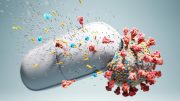


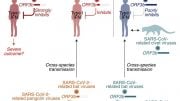
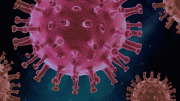
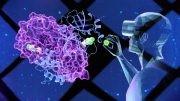

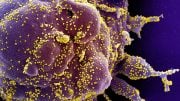
BY DESIGN…
The Corona “Virus” Never isolated, that’s why no video. LOL.
Funny part is most of the world and united states is vaxxed. Wonder if that has anything to do with all the new strains that didn’t take a year to pop up. And how bad covid is now. Can’t be s good thing to make humans cells produce viral RNA with non viral substances.
Well at least the more time you spend at this website the less ignorant you’ll get.
UK study just published results of a year long study showing 9 of 10 COVID deaths in the past year have been VACCINATED individuals.
It’s actually around 98% of the Covid deaths being among the unvaccinated. I can see how you could get that dead wrong though by being a shill.
Heya Tennis guy, you have a link or citation for your comment? Or naw? Are you the person who did the study therefore we can cite you, tennis guy?
Maybe if you didn’t smell of borsht and vodka, I’d take you at your word. Perhaps use data to support your Russian smellbot claims next time.
Interesting. This may explain relapse of chronic conditions after vaccinations.
Now, the study needs to measure the effect of known COVID “treatment” drugs on Mpro, including politically incorrect medications; namely Hydroxychloroquine and Ivermectin.
2Grams of Bovine Lactoferrin morning ” grams of Bovine Lactoferrin Evening kills all viruses in vivo ie in our bodies; take dose for one month because its slow acting but thorough’ research it & find out for your self; andrew langham uk
2 Grams of Bovine Lactoferrin morning 2 grams of Bovine Lactoferrin Evening kills all viruses in vivo ie in our bodies; take dose for one month because its slow acting but thorough’ research it & find out for your self; andrew langham uk
Lactoferrin is a nutrient classically found in mammalian milk. It binds iron and is transferred via a variety of receptors into and between cells, serum, bile, and cerebrospinal fluid. It has important immunological properties, and is both antibacterial and antiviral